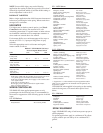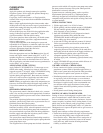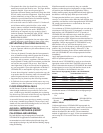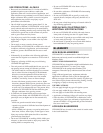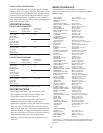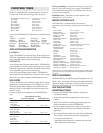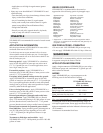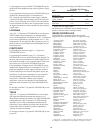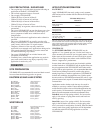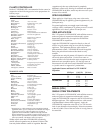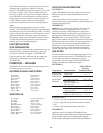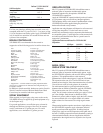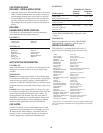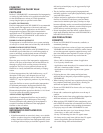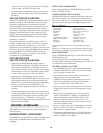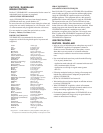
USE PRECAUTIONS - SUGARCANE
• Do not plant any crop other than sugarcane following an
application of DuPont™ VELPAR® DF.
• Do not feed sugarcane forage to livestock.
• Do not apply VELPAR® DF:
-Within 180 days of harvest in Hawaii.
-Within 234 days of harvest in Louisiana.
-Within 288 days of harvest in Puerto Rico.
-Within 234 days of harvest in Texas.
•To avoid injury to sugarcane, observe the following
precautions:
- Do not use VELPAR® DF on cane that shows poor vigor
because of insect damage, disease, or winter injury, or
shows symptoms of other stress conditions such as
drought stress.
- Do not add a surfactant in applications unless otherwise
specified.
- Do not use VELPAR® DF on gravelly or rocky soils,
thinly covered subsoils, or coarse-textured soils (sands to
sandy loams) with less than 1% organic matter.
-Temporary chlorosis of the crop may result from
application over emerged cane. Applications during active
cane growth should be directed to cover the weeds and
soil while minimizing crop contact.
- Do not use VELPAR® DF on varieties known to be
susceptible to herbicides.
• Extremely heavy rainfall after application may result in
poor weed control and/or crop injury, especially if the
application is made to dry soil.
SITE PREPARATION
VELPAR® DF is recommended for weed and brush control
in areas where the following species are grown:
EASTERN US AND LAKE STATES
WESTERN US
APPLICATION INFORMATION
EASTERN US
Apply VELPAR® DF from early spring to early summer
after hardwoods have broken bud and before the foliage has
hardened off.
VELPAR® DF(Lb/Acre)
Soils Eastern US
Coarse
Texture
Sand, loamy sand,
sandy loam 2 2/3 - 4
Medium
Texture
Loam, silt loam,
sandy clay loam 4 - 5 1/3
Fine
Texture
Silty clay loam,
clay loam, sandy clay,
silt, silty clay, clay 5 1/3 - 6 2/3
The rates listed are for broadcast application. Use the lower rates on
coarse textured soils and soils low in organic matter. Use the higher
rates on fine textured soils and soils high in organic matter. Use the
higher rates where weeds identified with an * in the Weeds
Controlled list predominate.
WESTERN US
For SITE PREPARATION, VELPAR® DF may be
applied at 1.3 to 4 pounds per acre. Use the lower rates on
coarse textured soils and soils low in organic matter. Use the
higher rates on fine textured soils and soils high in organic
matter. Use the higher rates where weeds identified in this
label as “suppression” predominate.
In areas where other conifer species may be mixed in with the
conifers listed above, VELPAR® DF may be applied if the user
has prior experience with VELPAR® DF on the other conifer
species. With no prior experience, it is recommended that either
a small area of plantings be tested for conifer safety prior to
treating larger areas, or make no application of VELPAR® DF
in these areas within the site preparation area. Conifer species
that are sensitive to VELPAR® (hexazinone) DF, such as, sugar
pine and western larch, require 18 months before interplanting
on treated sites.
Applications made to shelter wood sites may also result in
mortality to over-story conifers. Factors that may influence
conifer sensitivity in these sites could include application rate,
conifer species, soil characteristics, uniformity of spray distri-
bution across the treatment swath and environmental stress.
Rain Belt (areas of high spring rainfall): For best results,
apply in late winter or spring when weeds and brush are
actively growing.
Snow Belt (areas of low spring rainfall): For best results,
apply in the fall before soil freezes, or in the spring after
snow cover melts in anticipation of rainfall. Weed and brush
control results from spring applications will be dependent
on sufficient rainfall following application to activate
VELPAR® DF.
Fir, Douglas Pseudotsuga menziesii
Fir, grand Abies grandis
Fir, Noble Abies procera
Fir, white Abies concolor
Pine, Jeffrey Pinus jeffreyi
Pine, lodgepole Pinus contorta
Pine, ponderosa Pinus ponderosa
Spruce, blue Picea pungens
Spruce, Engleman Picea englemannii
Spruce, Sitka Picea sitchensis
Fir, balsam Abies balsamea
Pine, Austrian Pinus negra
Pine, loblolly Pinus taeda
Pine, longleaf Pinus palustris
Pine, ponderosa Pinus ponderosa
Pine, red Pinus resinosa
Pine, Scotch Pinus sylvestris
Pine, shortleaf Pinus echinata
Pine, slash Pinus elliottii
Pine, Virginia Pinus virginiana
Spruce, black Picea mariana
Spruce, red Picea rubens
Spruce, white Picea glauca
FORESTRY
12



